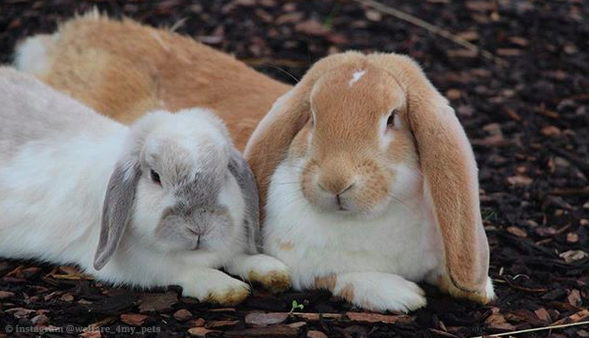Bonding
Bonding a Pair
Tips and information for bonding pairs of rabbits. Click here!
Bonding of Groups
Tips and information for bonding groups of rabbits. Click here!
Bonding Process
An in-depth explanation how to most effectively bond rabbits. Click here!
Bonding Behaviors
An in-depth explanation of the behaviors displayed during bonding. Click here!
Quarantine
Advice on the preparations prior to bonding. Click here!
• Socialization or bonding is more likely to be successful if rabbits are the same age
• Bonding of castrated male and female is ideal and often most successful
• Newcomers should be first quarantined so you may exclude existing diseases which may be dangerous
For every rabbit, a fitting partner can be found. Sometimes it may require more time, but one can always be found nevertheless. Even rabbits that have always lived alone, are sick, or shy, can be successfully bonded if you can just be aware of some points and adjust accordingly.
Socialization and bonding of rabbits is always different. There is no fixed method and there are many different methods that you must select according to the situation.
You have to approach bonding with lots of respect, regardless if you are an experienced rabbit keeper or not. Some keepers are too afraid to bond their alone-kept rabbit, with a partner, fearing fights or injuries. This should not be a reason because with patience and understanding, you can offer these animals a much happier life.
Young animals should be only bonded with adult rabbits after they are 16 weeks old. Their skin is very soft and can be ruptured easily. Bonding of same aged rabbits is ideal. A rabbit that is 6 months old will feel bored with a senior that is 8 years old and the senior will very quickly become annoyed with the younger rabbit. Age difference is less of a factor in large groups.
Sooner or later you must bond your rabbits. This can happen with the bonding of two animals or even a group. You must consider how you want to adjust the bonding. It is important to stay calm while bonding the animals and give it sufficient time so that they may establish their hierarchy. The length of the bonding can last from several hours to several weeks. This is because every animal and bonding situation is different.
While bonding you must regularly check your rabbits for injuries to act early enough if serious injury has occurred.
For successful bonding, here are some points to follow:
- Connector.
Rabbit Character
The character of the rabbits often depends on how the bonding will go. Dominant animals are more difficult to bond than others.
- Connector.
Gender Configuration
Gender configuration is also important in the speed and successfulness of the bonding.
- Connector.
Room Neutrality
The neutrality of the room is another key factor. There should be nothing to influence the hierarchy of the bonding rabbits.
- Connector.
Confidence, Mood & Health
The confidence of the keeper, the daily mood of the rabbits, and the health of the rabbits are also important factors.
